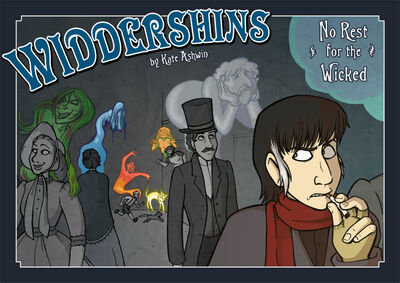You see the signs, but you can’t read
No Rest for the Wicked (Widdershins, volume 2)
By Kate Ashwin

7 Sep, 2016
0 comments
Widdershins: No Rest for the Wicked is the second arc in Kate Ashwin’s ongoing webcomic. No Rest for the Wicked was published in 82 installments from March 12, 2012 to October 5, 2012.
Detained by police after a friendly altercation at a local pub, Jack O’Malley and his amiable German chum Wolfe face either prison term or — this being a fantasy England with its own Bloody Code — execution. Jack has a very special talent and that makes him potentially valuable to Councilwoman Fairbairn. Valuable enough to buy both Jack and Wolfe out of prison.
Of course, a contract with the councilwoman is involved but if contracts ever said anything important, O’Malley would have learned to read.
Widdershins is “England’s magical epicentre, home to bounty hunters, failed wizards, stage magicians, and more besides.” Magic has always served the town well or at least well enough. Recently, there has been a plague of malforms, spiritual detritus created by miscast spells. Left alone, malforms run amok.
Wizard, third class Ben Thackery has the skills that can dispel the malforms, but he cannot see them. That’s where O’Malley comes in. O’Malley has the second sight. He may not be able to see colour, but he can see the spirits that swirl unseen around each and every person.
Wolfe? Well, he plays a mean violin.
Workshy O’Malley does not see why he should do a jot more work than he’s obligated to do. As long as he and Thackery can (barely) banish the flood of new malforms, who cares where they are coming from? Poor Wolfe, cursed with the twin maladies of curiosity and a keen intellect, cannot resist connecting the dots.
And that makes Wolfe far too dangerous to leave running around free on the streets.
~oOo~
Ashwin’s artwork is still awkward when it comes to action scenes, but perfectly serviceable otherwise.
It’s interesting that Ashwin rejects Victorian England’s egregiously sexist gender roles while retaining the Bloody Code. Modern readers (or at least the subset who read Widdershins) apparently prefer stories where women can play a full range of roles, from cops to robbers. Historical accuracy be damned. However, they’re OK with a draconian legal system under which minor infractions are punished with transportation or the noose. Why, one might guess that a majority of the readers come from some godforsaken place with a prison-industrial system fueled by finely targeted draconian laws.
O’Malley is forced to learn how summoning looks from the POV of the supernatural beings who are being thus coerced. He has a unique insight into poltergeist mindsets. He seems unlikely to share his newfound knowledge with those around him; that would be extra work. The field of malformology will have wait for its Faraday.
If you’ve read the first installment of Widdershins, you may be wondering what happened to Harry and Sid, previous protagonists. They do make a brief cameo in this volume, but we learn nothing new about them.
Ashwin has changed focus, from a set of energetic but foolish characters to a set of lazy ones. Both energy and laziness result in fatal entanglements. Presumably her focus will change again in the next chapter. Ashwin’s world is big enough for more than one band of adventurers.
Widdershins is updated regularly here, or if you prefer bound volumes it can be purchased here.
